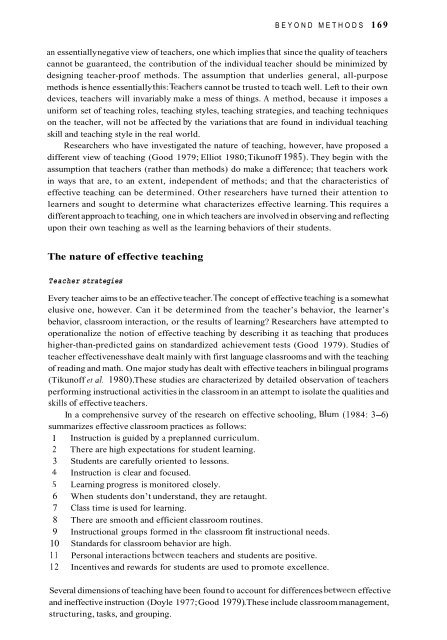English Language Teaching in its Social Context
English Language Teaching in its Social Context
English Language Teaching in its Social Context
You also want an ePaper? Increase the reach of your titles
YUMPU automatically turns print PDFs into web optimized ePapers that Google loves.
BEYOND METHODS 169an essentially negative view of teachers, one which implies that s<strong>in</strong>ce the quality of teacherscannot be guaranteed, the contribution of the <strong>in</strong>dividual teacher should be m<strong>in</strong>imized bydesign<strong>in</strong>g teacher-proof methods. The assumption that underlies general, all-purposemethods is hence essentially this:Teachers cannot be trusted to tcach well. Left to their owndevices, teachers will <strong>in</strong>variably make a mess of th<strong>in</strong>gs. A method, because it imposes auniform set of teach<strong>in</strong>g roles, teach<strong>in</strong>g styles, teach<strong>in</strong>g strategies, and teach<strong>in</strong>g techniqueson the teacher, will not be affected by the variations that are found <strong>in</strong> <strong>in</strong>dividual teach<strong>in</strong>gskill and teach<strong>in</strong>g style <strong>in</strong> the real world.Researchers who have <strong>in</strong>vestigated the nature of teach<strong>in</strong>g, however, have proposed adifferent view of teach<strong>in</strong>g (Good 1979; Elliot 1980; Tikunoff 1985). They beg<strong>in</strong> with theassumption that teachers (rather than methods) do make a difference; that teachers work<strong>in</strong> ways that are, to an extent, <strong>in</strong>dependent of methods; and that the characteristics ofeffective teach<strong>in</strong>g can be determ<strong>in</strong>ed. Other researchers have turned their attention tolearners and sought to determ<strong>in</strong>e what characterizes effective learn<strong>in</strong>g. This requires adifferent approach to teachng, one <strong>in</strong> which teachers are <strong>in</strong>volved <strong>in</strong> observ<strong>in</strong>g and reflect<strong>in</strong>gupon their own teach<strong>in</strong>g as well as the learn<strong>in</strong>g behaviors of their students.The nature of effective teach<strong>in</strong>gTeacher strategiesEvery teacher aims to be an effective teacher.The concept of effective teachng is a somewhatelusive one, however. Can it be determ<strong>in</strong>ed from the teacher’s behavior, the learner’sbehavior, classroom <strong>in</strong>teraction, or the results of learn<strong>in</strong>g? Researchers have attempted tooperationalize the notion of effective teach<strong>in</strong>g by describ<strong>in</strong>g it as teach<strong>in</strong>g that produceshigher-than-predicted ga<strong>in</strong>s on standardized achievement tests (Good 1979). Studies ofteacher effectiveness have dealt ma<strong>in</strong>ly with first language classrooms and with the teach<strong>in</strong>gof read<strong>in</strong>g and math. One major study has dealt with effective teachers <strong>in</strong> bil<strong>in</strong>gual programs(Tikunoff et al. 1980). These studies are characterized by detailed observation of teachersperform<strong>in</strong>g <strong>in</strong>structional activities <strong>in</strong> the classroom <strong>in</strong> an attempt to isolate the qualities andskills of effective teachers.In a comprehensive survey of the research on effective school<strong>in</strong>g, Blum (1984: 3-6)summarizes effective classroom practices as follows:1234S6789101 112Instruction is guided by a preplanned curriculum.There are high expectations for student learn<strong>in</strong>g.Students are carefully oriented to lessons.Instruction is clear and focused.Learn<strong>in</strong>g progress is monitored closely.When students don’t understand, they are retaught.Class time is used for learn<strong>in</strong>g.There are smooth and efficient classroom rout<strong>in</strong>es.Instructional groups formed <strong>in</strong> the classroom fit <strong>in</strong>structional needs.Standards for classroom behavior are high.Personal <strong>in</strong>teractions between teachers and students are positive.Incentives and rewards for students are used to promote excellence.Several dimensions of teach<strong>in</strong>g have been found to account for differences betwecn effectiveand <strong>in</strong>effective <strong>in</strong>struction (Doyle 1977; Good 1979) .These <strong>in</strong>clude classroom management,structur<strong>in</strong>g, tasks, and group<strong>in</strong>g.












